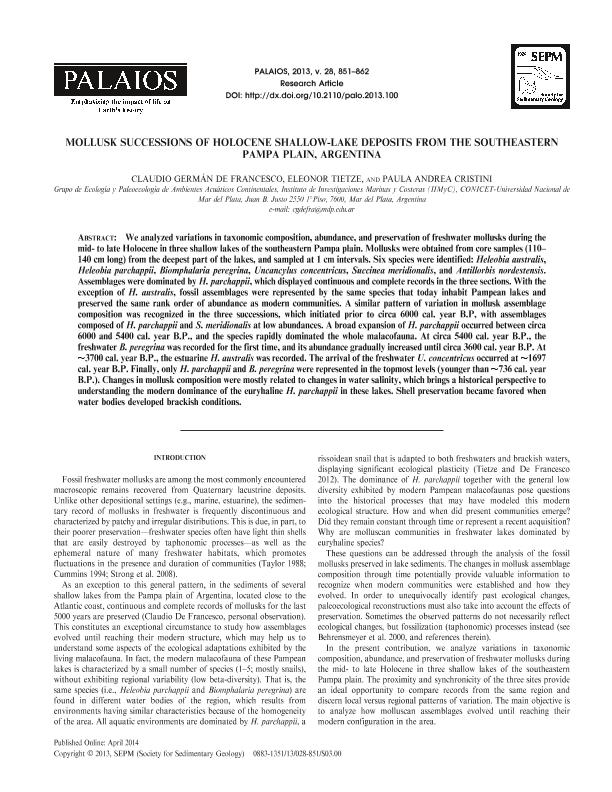Artículo
Mollusk successions of holocene shallow-lake deposits from the southeastern Pampa plain, Argentina
Fecha de publicación:
12/2013
Editorial:
Society for Sedimentary Geology
Revista:
Palaios
ISSN:
0883-1351
Idioma:
Inglés
Tipo de recurso:
Artículo publicado
Clasificación temática:
Resumen
We analyzed variations in taxonomic composition, abundance, and preservation of freshwater mollusks during the mid- to late Holocene in three shallow lakes of the southeastern Pampa plain. Mollusks were obtained from core samples (110–140 cm long) from the deepest part of the lakes, and sampled at 1 cm intervals. Six species were identified: Heleobia australis, Heleobia parchappii, Biomphalaria peregrina, Uncancylus concentricus, Succinea meridionalis, and Antillorbis nordestensis. Assemblages were dominated by H. parchappii, which displayed continuous and complete records in the three sections. With the exception of H. australis, fossil assemblages were represented by the same species that today inhabit Pampean lakes and preserved the same rank order of abundance as modern communities. A similar pattern of variation in mollusk assemblage composition was recognized in the three successions, which initiated prior to circa 6000 cal. year B.P, with assemblages composed of H. parchappii and S. meridionalis at low abundances. A broad expansion of H. parchappii occurred between circa 6000 and 5400 cal. year B.P., and the species rapidly dominated the whole malacofauna. At circa 5400 cal. year B.P., the freshwater B. peregrina was recorded for the first time, and its abundance gradually increased until circa 3600 cal. year B.P. At ∼3700 cal. year B.P., the estuarine H. australis was recorded. The arrival of the freshwater U. concentricus occurred at ∼1697 cal. year B.P. Finally, only H. parchappii and B. peregrina were represented in the topmost levels (younger than ∼736 cal. year B.P.). Changes in mollusk composition were mostly related to changes in water salinity, which brings a historical perspective to understanding the modern dominance of the euryhaline H. parchappii in these lakes. Shell preservation became favored when water bodies developed brackish conditions.
Palabras clave:
Paleoecology
,
Taphonomy
,
Gastropods
,
Freshwater.
Archivos asociados
Licencia
Identificadores
Colecciones
Articulos(IIMYC)
Articulos de INSTITUTO DE INVESTIGACIONES MARINAS Y COSTERAS
Articulos de INSTITUTO DE INVESTIGACIONES MARINAS Y COSTERAS
Citación
de Francesco, Claudio German; Tietze, Eleonor; Cristini, Paula Andrea; Mollusk successions of holocene shallow-lake deposits from the southeastern Pampa plain, Argentina; Society for Sedimentary Geology; Palaios; 28; 12; 12-2013; 851-862
Compartir
Altmétricas




